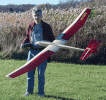|
September 1949 Popular Science
 [Table of Contents] [Table of Contents]
Wax nostalgic about and learn from the history of early
electronics. See articles from
Popular
Science, published 1872-2021. All copyrights hereby acknowledged.
|
 When reading this article about a 50-foot-diameter
inflatable radar antenna dome from a 1949 issue of Popular Science magazine,
I was surprised to learn it was only rated for withstanding 2 inches of snow. The
story says snow or ice, but 2 inches of ice would typically weigh an lot more than
2 inches of snow - even wet snow. That is not to say it cannot survive in regions
where more than 2 inches of snow is likely to fall. It cleverly uses a repetition
of partial deflation / inflation actions to flex the surface, thereby causing the
snow and/or ice to lose its grip and slide off. That sounds good in theory, but
I wonder how successful it really was under real-world conditions. If you do an
Internet search on some of those huge inflated sports arena domes in snowy locales,
you'll find plenty which
collapsed under heavy snow loads. That happened to the
Erie Sports Arena when we lived there. When reading this article about a 50-foot-diameter
inflatable radar antenna dome from a 1949 issue of Popular Science magazine,
I was surprised to learn it was only rated for withstanding 2 inches of snow. The
story says snow or ice, but 2 inches of ice would typically weigh an lot more than
2 inches of snow - even wet snow. That is not to say it cannot survive in regions
where more than 2 inches of snow is likely to fall. It cleverly uses a repetition
of partial deflation / inflation actions to flex the surface, thereby causing the
snow and/or ice to lose its grip and slide off. That sounds good in theory, but
I wonder how successful it really was under real-world conditions. If you do an
Internet search on some of those huge inflated sports arena domes in snowy locales,
you'll find plenty which
collapsed under heavy snow loads. That happened to the
Erie Sports Arena when we lived there.
Radar Takes Cover Under the "Big Top"

1 - Workmen at left are unrolling the radar
radome tarpaulin. A segment of the tent's skirt will then be fastened to the rim
of the semi-circular aluminum framework seen in the center.

2 - Here the radar radome goes up, much like
an old-fashioned buggy top, with the fabric supported by a series of hoops. It is
raised by ropes operating over pulleys on the V-shaped masts.

3 - This half-way-up view clearly shows the
raised circular concrete lip that rims the 50-foot-diameter floor. Wooden framework
in center surrounds entrance from underground tunnel.

4 - Coming down. Next step is to clamp the hem
of the radar radome's skirt to the concrete lip. After it has been inflated, the
hoops are collapsed and the raising derricks dismantled.
Radar, so long kept under wraps for security reasons, now has gone under cover
again. But this time it is "cover" in the literal meaning of the word - shelter
to protect expensive and delicate equipment from the destructive elements of nature
in extreme climates. "Radome" is the name for this balloon-like housing that is
thin as paper, sturdy as steel, and does not interfere with the transmission of
radar signals. Yet it is held up by air alone, with no supporting structures to
get in the way of a radar set's swinging arms.
The big fellow shown on these pages is an Air Force job. It is 36 feet high,
50 feet in diameter at the base, and is made of Fiberglas™ coated with synthetic
rubber. When inflated, it is strong enough to support two inches of snow or ice,
and to stand up under 130-m.p.h. winds. If internal heating is insufficient to remove
ice coatings, a "mechanical spanking" - a slight alternate deflation and inflation
- will do the trick. For hot climes, the big bag can be air-conditioned.

Baby radar radome takes a bow. It is shown deflated,
and serving as a cover for the gun-directing radar set that is being raised from
its trailer storage compartment.

Bubbled, the thin fabric is held up by an internal pressure of
only 1/4 lb. per sq. in. from a vacuum cleaner.

5 - All blown up. Engineer walking up the side
with the aid of a rope doesn't even make a dent in the taut fabric. Special pressurizing
machinery is used for inflating the big top.
Illustrated at the bottom of this page is the baby counterpart that does the
same job for the Signal Corps' mobile radar units. Nine feet in diameter, this miniature
version is made of Neoprene™-coated Fortisan™ rayon, which, says the
Signal Corps, transmits radar signals better. It is inflated by a unit from an ordinary
tank-type vacuum cleaner.
Both radomes were designed by the Cornell Aeronautical Laboratory, Buffalo, N.
Y., in conjunction with the Air Force's Watson Laboratories and the Signal Corps
Engineering Laboratories.
Posted February 19, 2024
|
















